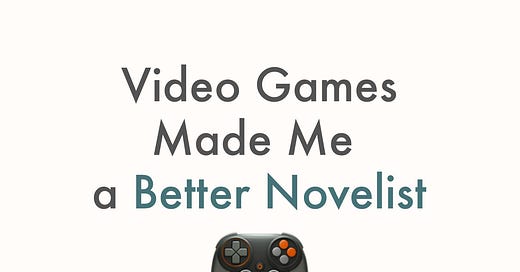Last year, I took a job as a narrative designer at a video game company. Here are three things I learned while writing for video games that made me a better novelist.
1. Plot Is Your Friend
External conflict does not work without internal conflict. And for the literary fiction writers out there like myself: internal conflict absolutely does not work without external conflict. How do you write a story with both external and internal conflict?
Ask yourself two questions.
Question #1: What concrete thing does my character want?
To test that their goal is concrete, it should fall into one of four categories: win, stop, escape, or retrieve. If it doesn’t, it’s not concrete enough and your external conflict will likely be too weak
Question #2: What is my character’s core misbelief?
This will point to their internal need and work best if it drives their external goal. E.g. AJ wants to rob a bank (retrieve goal) because his misbelief is that money will give him freedom.
An effective story would show how AJ’s misbelief is false (internal conflict) as he progresses toward his concrete goal (external conflict).
2. Theme Is Key
You might be asking, “How do I find my character’s misbelief?” Misbelief is tied to theme. Before writing game narratives, I thought theme was something that naturally manifested in a story. I couldn’t have been more wrong.
Theme drives the story’s tone, pitch, and audience. Theme is only effective if it drives your characters too. To find the misbelief, find your theme first. What lesson does the protagonist need to learn? Write down your theme, then write down the opposite. That’s the misbelief.
Let’s continue with the robbery example:
Theme: Greed is a prison.
Misbelief: Money gives you freedom.
3. Outlines Improve Pacing and Save Time in Revision
If you’re a discovery writer and your process is working, feel free to keep scrolling. I used to be a discovery writer, but it did not work for me for three reasons:
Throwing out countless pages in revision felt like a waste of time
That feeling made me hostile toward the revision process
Improving the pacing of my novel felt tedious because I was constantly going down the wrong path before I found the right one
Writing video games taught me that finding a story structure that resonated with how I understand narrative was not a useless constraint. Instead, structure gave me the freedom to be more creative and enjoy the writing process because I had a framework to make sure that: (1) the story finds an effective pacing in earlier drafts and (2) the protagonist is constantly making progress toward their concrete goal (external conflict) while battling their misbelief (internal conflict).
There are a lot of different story structures out there to explore. Here are some of the resources I’ve found useful:
Abbie Emmons’s Video on Character Misbelief
Save the Cat Writes a Novel by Jessica Brody
The Story Solution by Eric Edson
Here at Craft with Kat, we do deep dives into the structures that have helped me in my writing life. If you’re just now joining us, check out our free lessons to get started:
If these lessons resonate with your understanding of story, head over to our most popular lesson on character goals next.
What unexpected things made you a better writer? Share your experiences in the comments.
See you in the next post.
– Kat




This is a very analytical look at writing and asking yourself essentially what are the canonical elements that make a story work: Themes, internal and external conflicts and core misbeliefs of character. Following a structure can take the “guesswork” out of writing and make inspiration to seem less mysterious, but more pragmatic.